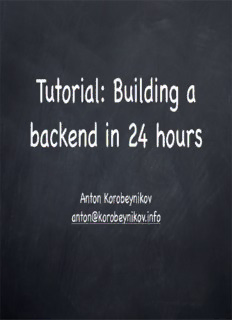
Anton Korobeynikov PDF
Preview Anton Korobeynikov
Tutorial: Building a backen d in 24 hours Anton Korobeynikov [email protected] Outline 1. Codegen phases and parts 2. The Target 3. First steps 4. Custom lowering 5. Next steps Codegen Phases • Preparation Phases • Selection DAG Phases • Late Optimizations • Register Allocation • Post-RA Phases • Code Emission (Assembler Printing and/or Binary Code Emission) SelectionDAG Phases • Lower • Combine • Legalize • Combine • Instruction Selection • Schedule Check excellent Dan’s talk at 2008 Dev. Meeting! Register Allocator Here magic starts - virtual registers are turned into physical ones ... See Lang’s talk today for more information Post-RA Phases • Prologue / Epilogue Insertion & Abstract Frame Indexes Elimination • Post-RA Scheduler • Branch Folding • Target-specific passes (e.g. IT block formation on Thumb2, delay slot filler on Sparc) Backend • Standalone library • Mixed C++ / TableGen • TableGen is a special DSL used to describe register sets, calling conventions, instruction patterns, etc. • Inheritance and overloading is used to augment necessary target bits into target-independent codegen classes Backend • Target & Subtarget: X86Subtarget.cpp, X86Target.cpp • Lowering: X86ISelLowering.cpp • Register Set: X86RegisterInfo.td • Register Information: X86RegisterInfo.cpp • Instructions: X86InstrInfo.cpp, X86InstrInfo.td & around • Instruction selection: X86ISelDAGToDAG.cpp • Calling Convention: X86CallingConv.td + asm printer, JIT hooks, etc. MSP430 MCU • 16-bit RISC-based MCU • 1/8/16-bit Data &16-bit Pointers • Powerful addressing modes • Simple instruction set: 27 instructions in 3 groups • Most instructions are available in 8-bit and 16-bit variants First Steps Consider the following code: define void @foo() { entry: ret void } What should we implement to let this code compile?
Description: